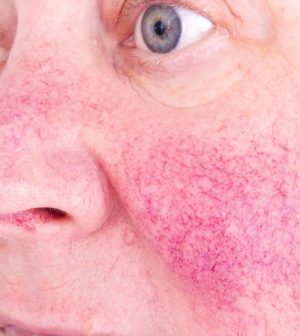- Navigating Your Midlife Crisis: Embracing New Possibilities
- City Raccoons Showing Signs of Domestication
- Mapping the Exposome: Science Broadens Focus to Environmental Disease Triggers
- One Week Less on Social Media Linked to Better Mental Health
- Your Brain Changes in Stages as You Age, Study Finds
- Some Suicide Victims Show No Typical Warning Signs, Study Finds
- ByHeart Formula Faces Lawsuits After Babies Sickened With Botulism
- Switch to Vegan Diet Could Cut Your Greenhouse Gas Emissions in Half
- Regular Bedtime Does Wonders for Blood Pressure
- Dining Alone Could Mean Worse Nutrition for Seniors
Could You Have Rosacea?

Acne isn’t reserved for teens, and breakouts can persist into adulthood. But there’s another common skin condition — rosacea — that causes a different type of blemish, strikes in the adult years, and won’t respond to typical acne products.
The first telltale sign of rosacea is the tendency to blush or flush easily. You might notice redness across your nose and cheeks. The discoloration may extend to your forehead, chin and ears, as well as chest and back. Other signs are acne-like breakouts, thick and bumpy skin and, for some, red, irritated eyes.
Here are some rosacea warning signs:
- Passing or permanent redness on the cheeks, nose and beyond.
- Small visible blood vessels on the surface of the face.
- Bumps or pimples on the face.
- Watery or irritated eyes and swollen eyelids.
Although the exact cause is unknown, rosacea tends to run in families and can be set off by triggers ranging from the sun and stress to wine and spicy foods. Many of the 16 million Americans living with rosacea are between 30 and 50 years old and have fair skin, blonde hair and blue eyes.
Unlike teen acne, which often clears up eventually, untreated rosacea can continue to worsen indefinitely. It also leads to varying degrees of distress and lifestyle restrictions from skipping certain foods to skipping social engagements out of embarrassment.
But there’s help available, so don’t ignore warning signs or put off seeing a dermatologist and getting treatment. Options include topical treatments, antibiotics and laser therapy to zap visible blood vessels. Also, work with your doctor to pinpoint your unique triggers so you can avoid them and limit flares.
More information
The National Rosacea Society offers detailed information on the condition, including when to see a doctor, advances in treatment, and other self-care steps.
Source: HealthDay
Copyright © 2025 HealthDay. All rights reserved.










